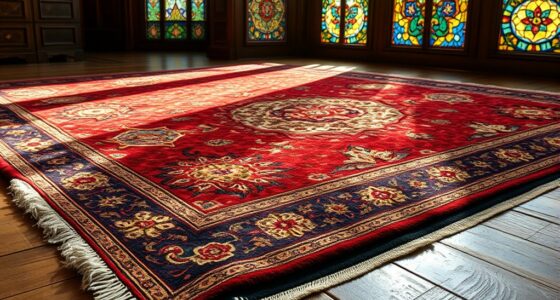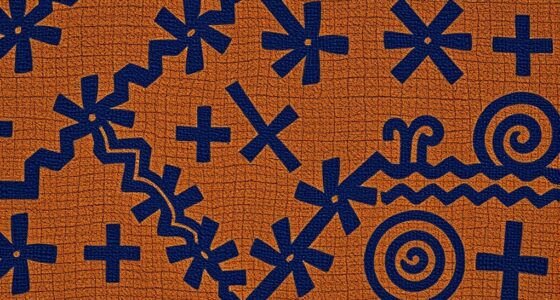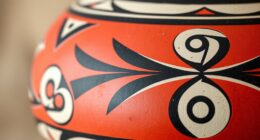Persian rugs have a rich history spanning thousands of years, showcasing regional artistry through unique styles, patterns, and symbolism. You’ll find intricate motifs like floral medallions, geometric shapes, and animal symbols, each telling stories and cultural beliefs. Traditional materials like wool and natural dyes highlight expert craftsmanship. External influences and historical events have shaped their designs, while modern trends blend tradition with innovation. Explore further to uncover the fascinating world behind these timeless textiles.
Key Takeaways
- Persian rugs originate from ancient times, reflecting regional culture, history, and craftsmanship passed through generations.
- Distinct regional styles like Tabriz, Kashan, and Baluch feature unique motifs, patterns, and symbolism.
- Materials such as wool and cotton, combined with natural dyes and traditional techniques, ensure durability and vibrant colors.
- Historical influences, including trade and conquests, have shaped diverse design elements and motifs.
- Contemporary trends blend traditional motifs with modern aesthetics, emphasizing sustainability and innovative craftsmanship.
Origins and Evolution of Persian Rug Weaving
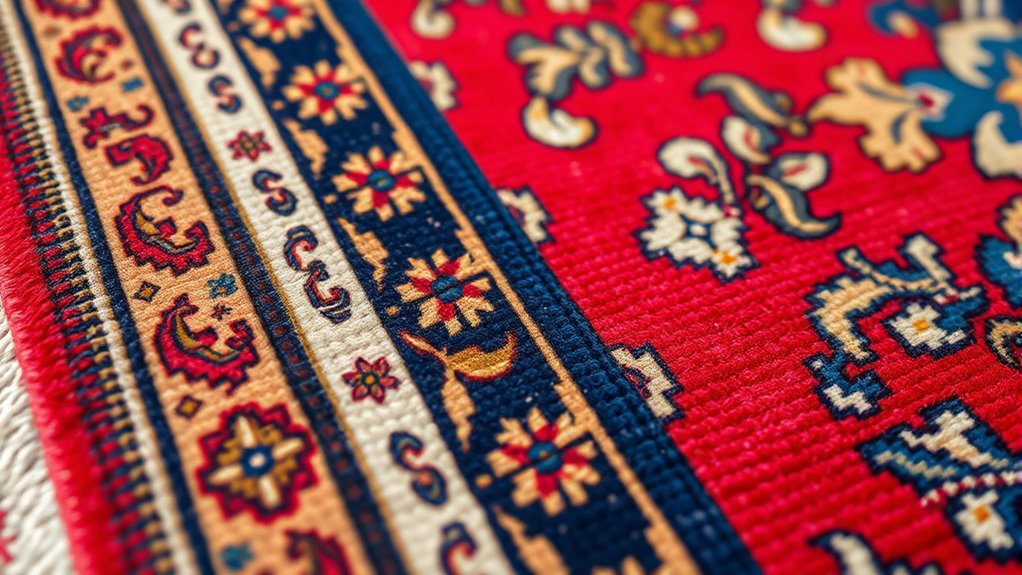
Persian rug weaving has a rich history that dates back thousands of years, reflecting the diverse culture and artistry of the region. You’ll notice that traditional knotting techniques, such as the symmetrical and asymmetrical knots, form the foundation of these exquisite rugs. These methods determine the rug’s durability and design complexity. Early artisans mastered dye extraction from natural materials like plants, insects, and minerals, creating vibrant, lasting colors. Over time, weaving styles evolved, influenced by regional traditions and trade routes, but the core techniques remained consistent. This evolution allowed Persian rugs to develop distinctive patterns and motifs, showcasing craftsmanship passed down through generations. Your appreciation deepens when you understand how these knotting techniques and natural dyes shaped the timeless beauty of Persian rugs.
Geographic Regions and Their Unique Styles
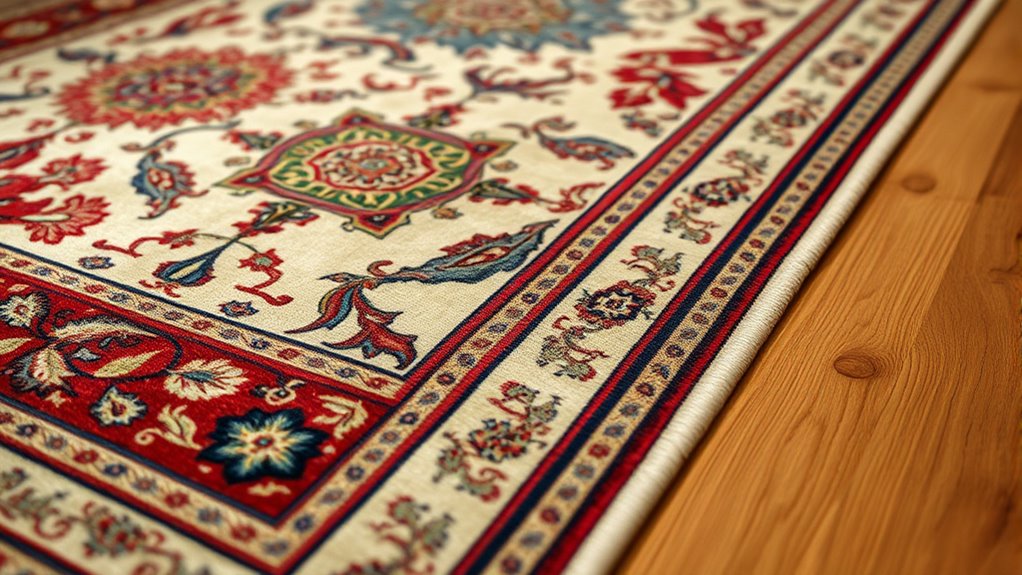
Because different regions across Persia developed their own distinct weaving traditions, each area produces rugs with unique styles and motifs that reflect local culture and materials. You’ll notice that geographic regions influence the design, colors, and patterns of Persian rugs, giving each a distinct identity. For example, you might recognize:
Different Persian regions create unique rugs reflecting local culture and materials.
- *Tabriz rugs*, known for intricate floral motifs and detailed medallions
- *Kashan rugs*, featuring elegant, symmetrical patterns with soft color palettes
- *Baluch rugs*, characterized by bold geometric shapes and earthy tones
- The specific weaving techniques used in each region further contribute to the diversity and authenticity of Persian rugs.
Traditional Materials and Dyeing Techniques
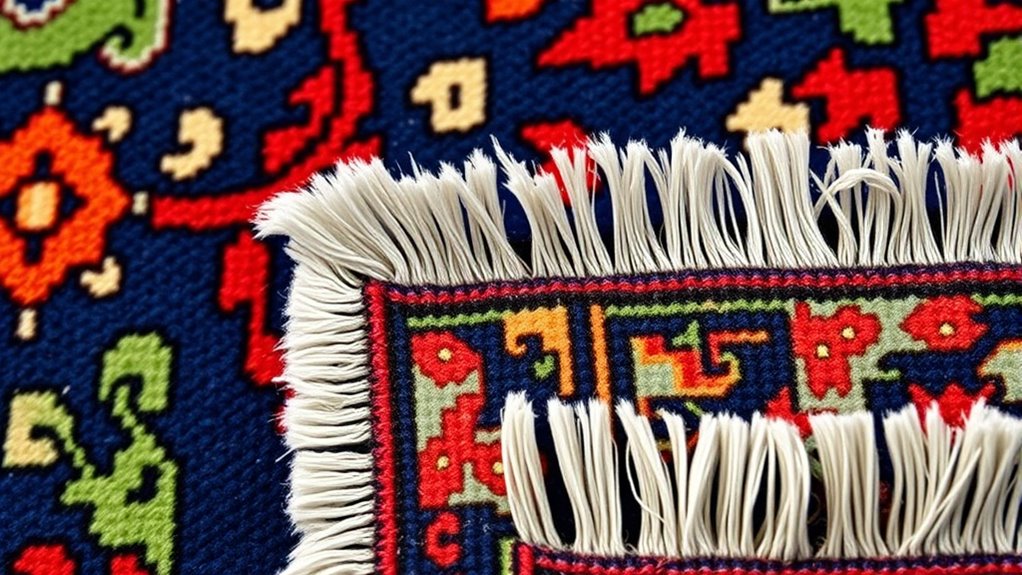
You’ll notice that traditional Persian rugs rely heavily on natural dyes and pigments derived from plants, minerals, and insects. The fibers used, like wool and cotton, are carefully selected for durability and vibrancy. These materials and techniques give Persian rugs their rich, lasting colors and unique textures. Additionally, artisans often use advanced dyeing techniques to achieve complex patterns and shades that have been preserved through generations.
Natural Dyes and Pigments
Have you ever wondered how artisans achieved those vibrant, lasting colors in Persian rugs? It all comes down to natural dyes and pigments. They primarily used plant-based dyes, derived from roots, leaves, and bark, to produce rich reds, yellows, and blues. Mineral pigments, like ochre and malachite, added earthy tones and durability to the dyes. These materials were carefully prepared through traditional techniques, such as boiling or fermenting, to extract vivid colors. Here’s what you should know:
- Plant-based dyes provided bright, eco-friendly hues.
- Mineral pigments contributed stability and a natural palette.
- The dyeing process involved meticulous hand-dyeing to ensure colorfastness.
- Scientific analysis of natural dyes reveals how chemical properties influence color stability and longevity.
This natural approach created the characteristic depth and longevity of Persian rug colors.
Wool and Cotton Fibers
Did you ever wonder what materials artisans used to craft the sturdy foundations of Persian rugs? They primarily relied on wool and cotton fibers. Wool, especially dyed wool, is valued for its durability, softness, and vibrant colors. Artisans carefully select high-quality wool, often dyeing it with natural pigments to achieve rich hues. Cotton threads serve as the foundation’s warp and weft, providing strength and stability. Cotton’s smooth texture complements wool’s flexibility, ensuring the rug maintains its shape over time. These materials are woven with precision, using traditional techniques passed down through generations. The combination of dyed wool and cotton threads results in a resilient, beautifully colored rug that endures centuries while showcasing intricate design elements. This craftsmanship highlights the importance of natural fibers in Persian rug making. Furthermore, the dyeing techniques employed often involve natural dyes derived from plants and minerals, which contribute to the lasting vibrancy of the colors.
Symbolism and Motifs in Persian Designs
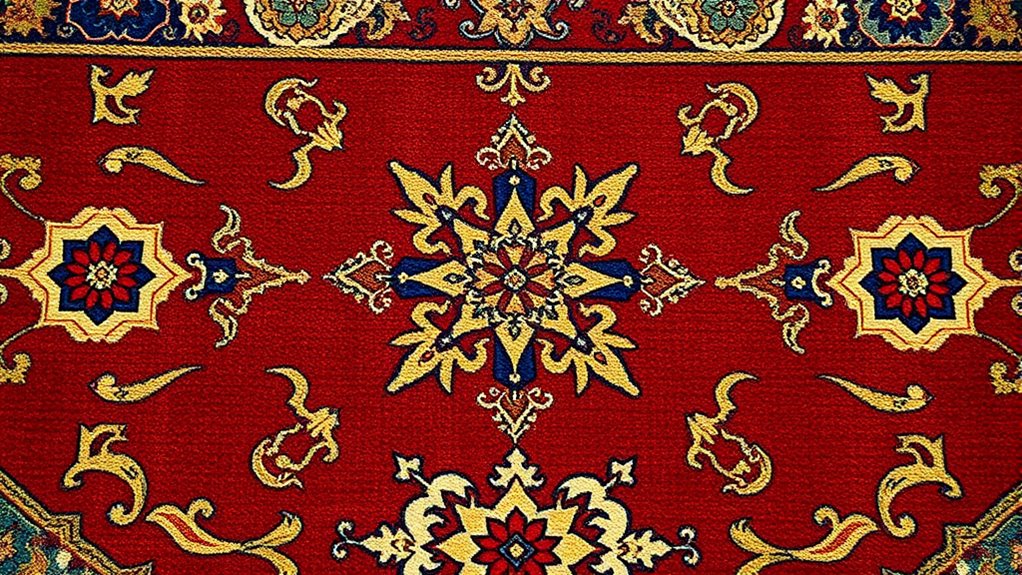
Have you ever wondered why Persian rugs feature such intricate and meaningful motifs? These designs are rich in symbolism, often reflecting cultural beliefs and natural elements. You’ll notice patterns like:
Persian rug motifs are deeply symbolic, reflecting cultural beliefs, natural elements, and stories woven into every pattern.
- Geometric patterns representing cosmic order or protection
- Floral motifs symbolizing paradise, fertility, or renewal
- Animal or mythological symbols conveying spiritual stories or values
Each motif isn’t random; it’s carefully chosen to tell a story or convey a message. For example, floral motifs often symbolize paradise or eternal life, while geometric patterns can serve as talismans. Additionally, the use of patterns in design demonstrates the importance of symbolism in cultural storytelling. By understanding these symbols, you gain deeper appreciation for the artistry and cultural significance woven into every Persian rug.
The Role of Weaving in Persian Culture
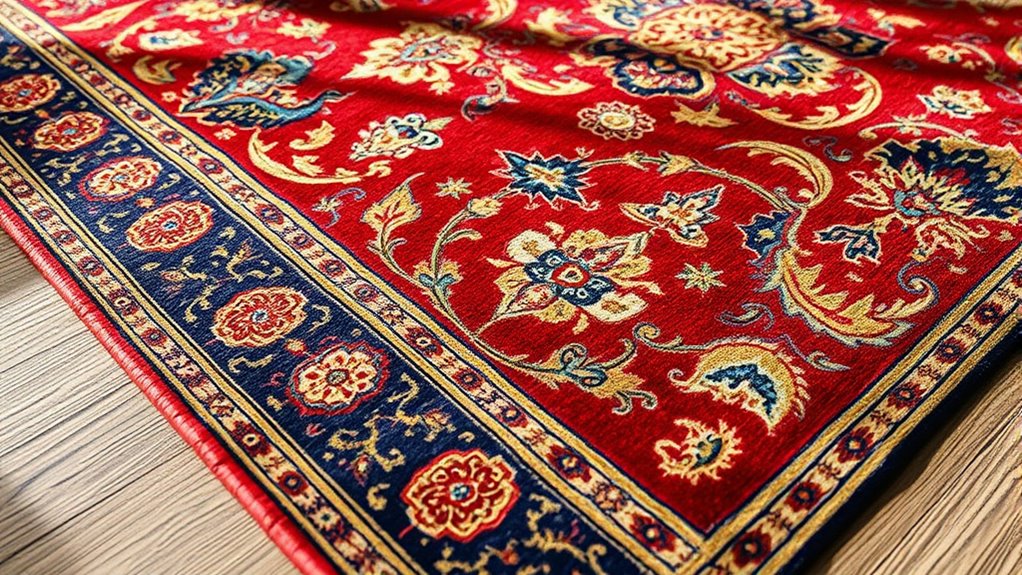
Weaving holds a vital place in Persian culture, serving not only as a craft but also as a reflection of identity and tradition. Your participation in weaving traditions connects you to a rich history that spans centuries. It’s more than creating rugs; it’s a cultural expression passed down through generations. The cultural significance of weaving is evident in its role within communities, symbolizing unity, craftsmanship, and heritage. Additionally, the economic impact of weaving practices has contributed to the livelihoods of many artisans and their communities.
Iconic Patterns and Their Meanings
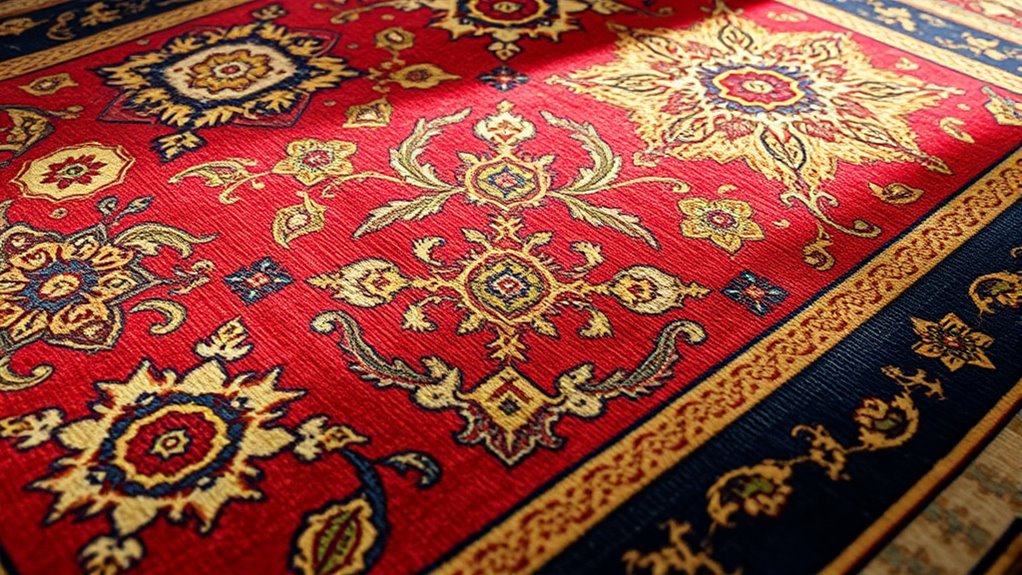
You’ll notice that each pattern in Persian rugs carries specific symbolism, reflecting cultural beliefs and stories. Different regions develop unique motifs, adding regional significance to each design. Understanding these variations helps you appreciate the rich history woven into every rug. For example, traditional and modern options can be combined to create a unique and meaningful aesthetic.
Symbolism Behind Motifs
Many motifs found in Persian rugs carry deep symbolic meanings that reflect cultural beliefs, spiritual values, and local traditions. These symbols often convey messages about protection, fertility, or harmony. For example, geometric abstraction can represent the universe’s order or spiritual unity, while floral symbolism often signifies growth and renewal. You’ll notice that:
- Geometric patterns symbolize protection and the infinite nature of life
- Floral motifs embody fertility, beauty, and spiritual awakening
- Repeated designs create a sense of harmony and balance in the rug’s narrative
- Recognizing these symbolic meanings enhances appreciation of the craftsmanship and cultural significance woven into each rug.
Regional Pattern Variations
Regional pattern variations in Persian rugs showcase a diverse array of iconic designs, each carrying unique meanings rooted in local culture and history. Kaleidoscope motifs are common in certain regions, creating intricate, symmetrical patterns that symbolize harmony and spiritual unity. Floral medallions are another hallmark, often representing paradise or divine gardens, and vary in style based on geographic origin. For example, rugs from Kashan may feature elaborate floral medallions, while Tabriz weavers favor more complex, layered designs. These patterns reflect regional flora, beliefs, and artistic traditions, allowing you to identify the rug’s origin at a glance. Recognizing these variations enriches your appreciation of Persian rugs, revealing stories woven into their patterns that go beyond mere decoration. Additionally, understanding regional biodiversity influences can deepen your insight into the natural motifs and symbolism present in these intricate designs.
The Craftsmanship and Artisanship Behind Persian Rugs
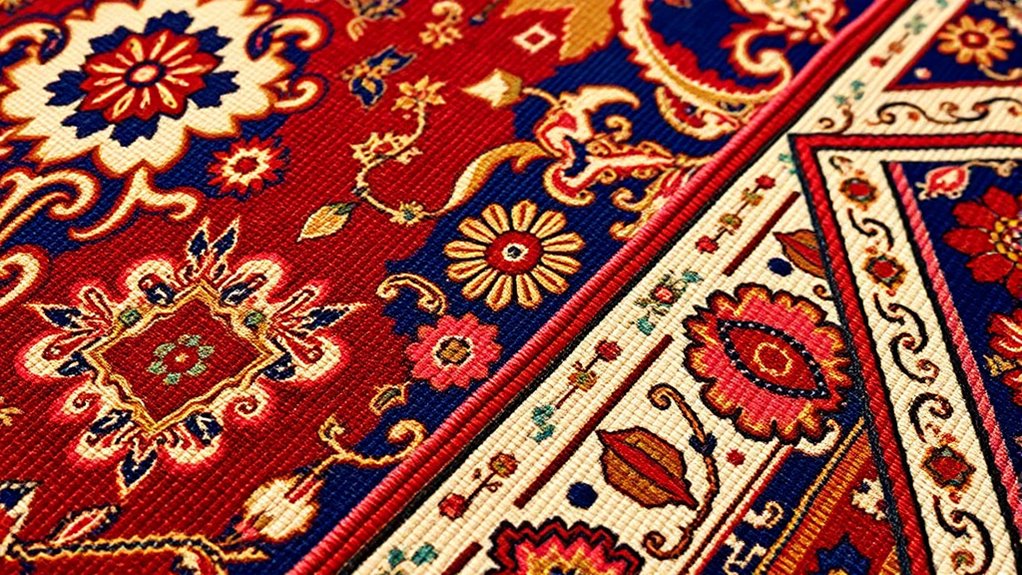
The craftsmanship behind Persian rugs is a proof of centuries of skill and tradition, where artisans meticulously transform raw materials into intricate works of art. These master craftsmen use specialized weaving techniques to create detailed patterns and durable textures. In artisan workshops, they dedicate hours to perfecting each rug, often passing skills down through generations. You’ll notice the precision in knotting and the choice of high-quality dyes, which ensure longevity and vibrancy. The tanning and dyeing processes play a crucial role in achieving the rich colors and durability seen in authentic Persian rugs. This craftsmanship not only elevates the beauty of each rug but also preserves a rich cultural heritage that continues to thrive today.
Influences of Historical Events on Rug Designs
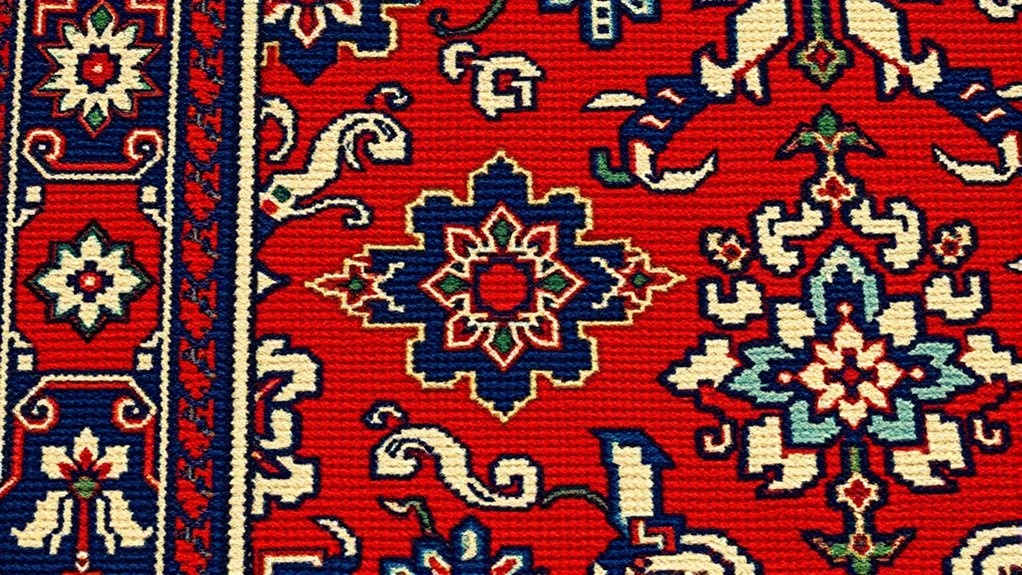
Historical events like wars and conquests have shaped the patterns you see in Persian rugs, reflecting periods of turmoil or change. Cultural exchanges, often resulting from trade or invasions, introduce new motifs and techniques into traditional designs. Understanding these influences helps you appreciate how history leaves its mark on every woven detail. Additionally, the incorporation of new design elements from different regions often signifies periods of cultural integration and adaptation.
War and Conquest Patterns
Have you ever noticed how war and conquest leave their mark on Persian rugs? You might see battle motifs and conquest symbols woven into their intricate patterns, reflecting historical struggles. These designs serve as storytelling tools, commemorating victories or honoring warriors. You’ll find common elements like shields, swords, and flags intertwined with floral or geometric motifs, symbolizing strength and resilience. Rugs from this era often feature:
- Battle scenes in detailed borders
- Symbols representing victorious tribes
- Motifs depicting conquest and unity
These patterns aren’t just decorative; they carry deep cultural meaning, embodying the history of conflict and triumph. By examining these designs, you connect with Persia’s turbulent past, recognizing how war shaped its artistic heritage.
Cultural Exchange Influence
Cultural exchanges have profoundly shaped Persian rug designs, blending motifs and techniques from neighboring regions and distant lands. These exchanges introduce new patterns, colors, and weaving methods, resulting in a rich artistic fusion. Historical trade routes like the Silk Road facilitated the spread of ideas and craftsmanship, allowing Persian weavers to incorporate influences from Asia, the Middle East, and even Europe. This cross-pollination enriches rug motifs with symbols and styles that reflect diverse cultural identities. As a result, Persian rugs became more than functional textiles; they evolved into a visual dialogue of history and tradition. You can see this influence in the intricate borders, stylized floral patterns, and geometric shapes that demonstrate a continuous exchange of artistic ideas across borders and centuries. Additionally, the influence of AI on design has begun to inspire innovative motifs and patterns in contemporary rug-making, merging traditional craftsmanship with modern technology.
Modern Interpretations and Trends in Persian Textiles
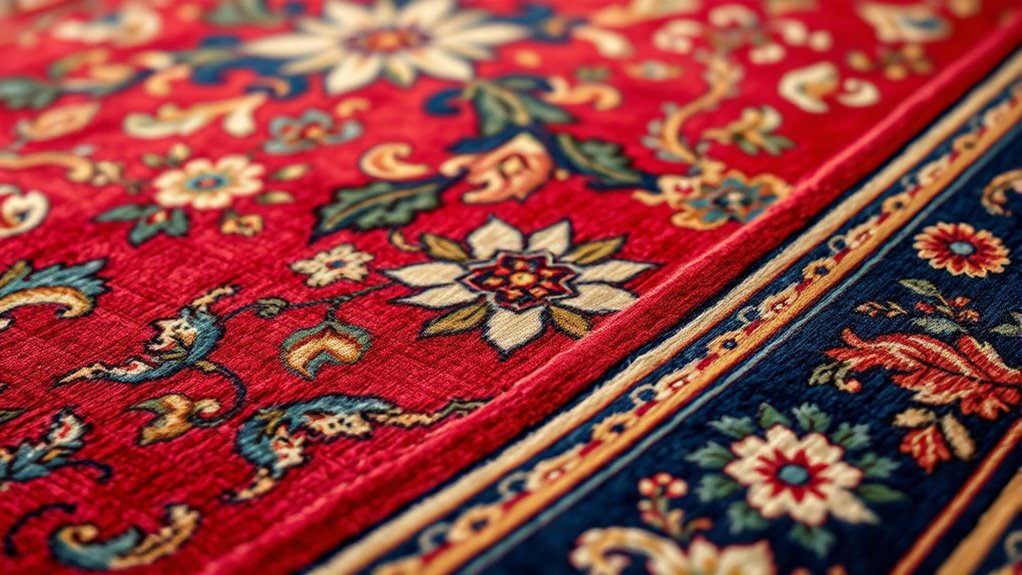
Modern interpretations of Persian textiles blend traditional motifs with contemporary design, creating pieces that resonate with today’s aesthetic sensibilities. You’ll notice a focus on textile innovation, incorporating new techniques and materials to refresh classic patterns. These trends emphasize minimalism, bold color palettes, and abstract forms that appeal to modern tastes. Incorporating certifications and endorsements from beauty experts, manufacturers ensure the authenticity and quality of their innovative textiles.
- Use of digital printing and synthetic fibers to achieve vibrant, durable designs
- Fusion of traditional Persian motifs with global art influences
- Emphasis on sustainable practices and eco-friendly materials
Caring for and Preserving Persian Rugs
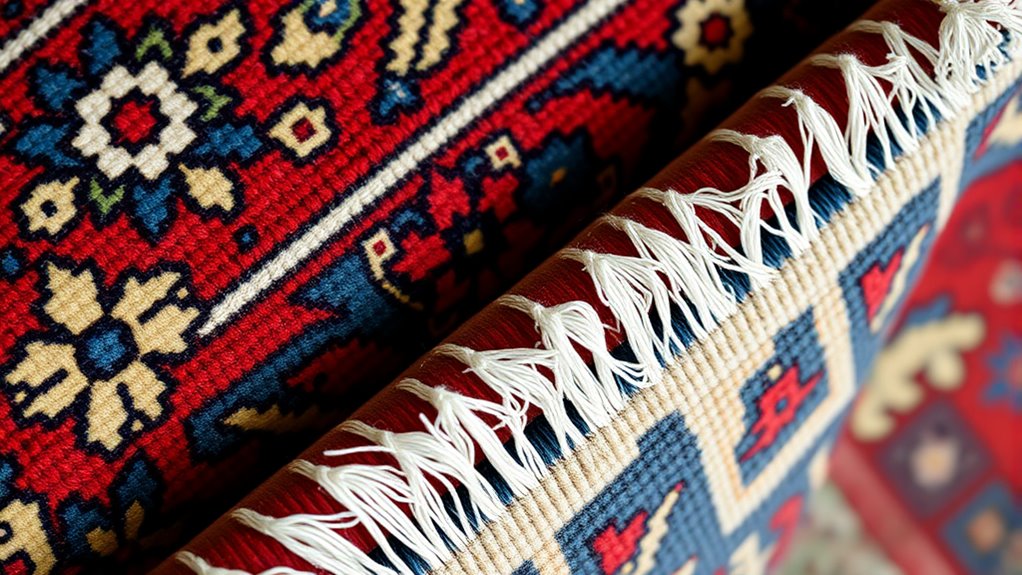
Caring for and preserving Persian rugs requires careful attention to prevent damage and maintain their beauty over time. Regular rug cleaning is essential; vacuum gently without the beater bar to avoid fiber damage. Protect your rug from direct sunlight, which can fade vibrant dyes. When stains occur, address them promptly with professional cleaning instead of DIY methods that might cause harm. For antique restoration, consult specialists experienced in preserving the rug’s original craftsmanship. Avoid excessive moisture, which can lead to mold or fiber deterioration. Rotate your rug periodically to prevent uneven wear. Proper storage during off-seasons involves rolling the rug (not folding) and wrapping it in breathable material. Additionally, understanding the intricacies of traditional weaving techniques can help in assessing the rug’s authenticity and value. These practices help ensure your Persian rug remains a beautiful, valuable heirloom for generations.
Frequently Asked Questions
How Do Persian Rug Designs Influence Contemporary Interior Decorating?
Persian rug designs influence your modern interior by adding rich patterns and vibrant colors that create a striking focal point. You can seamlessly integrate these traditional elements into contemporary spaces, blending old-world charm with modern aesthetics. Their intricate motifs and craftsmanship elevate your decor, making it more inviting and unique. By incorporating Persian rugs, you enhance your interior’s design, achieving a perfect balance between tradition and modernity.
What Are Common Mistakes to Avoid When Purchasing a Persian Rug?
When buying a Persian rug, avoid choosing the wrong rug size for your space, as it can overwhelm or underwhelm the room. Also, don’t fall for pricing strategies that seem too good to be true—set a realistic budget and compare prices. Always verify the rug’s authenticity, craftsmanship, and condition. Doing so guarantees you make a smart purchase, enjoying a beautiful piece that complements your decor for years to come.
Are There Regional Differences in the Craftsmanship of Persian Rugs?
Yes, there are regional differences in Persian rug craftsmanship. You’ll notice distinct regional motifs that reflect local culture and history, and weaving techniques that vary from one area to another. For example, some regions emphasize intricate floral patterns, while others focus on bold geometric designs. Understanding these variations helps you appreciate the unique craftsmanship behind each rug, ensuring you choose an authentic piece that truly represents its origin.
How Can I Authenticate the Age of a Persian Rug?
To authenticate the age of a Persian rug, focus on age verification and authenticity markers. Examine the wear and patina; older rugs develop a soft sheen and slight fading. Look for authentic hand-knotted craftsmanship, irregularities, and natural dyes that fade over time. Consult an expert for precise appraisal, as they can assess these markers accurately. Remember, genuine antique Persian rugs often show signs of age that artificial reproductions lack.
What Preservation Techniques Best Maintain the Vibrancy of Antique Persian Rugs?
To keep your antique Persian rug vibrant, focus on dye stabilization and wool treatment. Use gentle cleaning methods and avoid harsh chemicals that can fade colors. Regularly vacuum without damaging fibers, and consider professional wool treatment to maintain softness and prevent deterioration. Store your rug in a cool, dry area away from direct sunlight, which can cause fading. These preservation techniques help guarantee your rug retains its rich, original hues for years to come.
Conclusion
As you explore Persian rugs, you’re stepping into a tapestry woven with centuries of history and soul. Each knot and color whispers stories of ancient lands and passionate artisans. By appreciating their craftsmanship and symbolism, you become part of a living tradition, like holding a piece of art that dances between history and modernity. These rugs are more than textiles—they’re timeless melodies spun into vibrant, enduring masterpieces.




